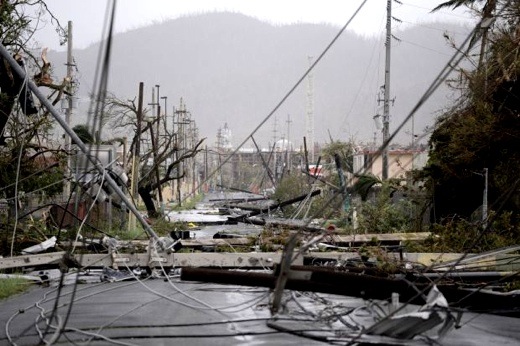SUBHEAD: Never before have irrationality and immorality had such a firm hold on the US government.
By Paul Craig Roberts on 10 September 2018 for PaulCraigRoberts.org -
(
https://www.paulcraigroberts.org/2018/09/10/armageddon-rides-in-the-balance/)
 Image above: Many in this world inhabit Armageddon already. Damaged buildings are seen at the Yarmouk Palestinian camp in Damascus, Syria. April 28, 2018. Photo by Omar Sanadiki. From (https://www.thenational.ae/world/mena/syria-regime-and-rebels-agree-evacuation-deal-in-southern-damascus-1.725770).
IB Publisher's note: Yes Paul Craig Roberts is a nutcake. He is a Ronald Reagan Republican economist who sees clearly, but through a deeply colored filter. None the less, he does have an inkling of the dichotomy between the "Left" and the "Right". The "Left" with elements of the "Deep State" (intelligence complex, CIA, NSA, State Department, etc) and the "Right" with elements of the "Military-Industrial Complex" (Pentagon, Defense contractors, Mercenary operations, ICE, etc.). Both aspects of our government are hurtling towards a more repressive and garrulous America. As these aggressive and regressive forces gain influence, woe is us. America will conduct more war and experience more repression.]
Image above: Many in this world inhabit Armageddon already. Damaged buildings are seen at the Yarmouk Palestinian camp in Damascus, Syria. April 28, 2018. Photo by Omar Sanadiki. From (https://www.thenational.ae/world/mena/syria-regime-and-rebels-agree-evacuation-deal-in-southern-damascus-1.725770).
IB Publisher's note: Yes Paul Craig Roberts is a nutcake. He is a Ronald Reagan Republican economist who sees clearly, but through a deeply colored filter. None the less, he does have an inkling of the dichotomy between the "Left" and the "Right". The "Left" with elements of the "Deep State" (intelligence complex, CIA, NSA, State Department, etc) and the "Right" with elements of the "Military-Industrial Complex" (Pentagon, Defense contractors, Mercenary operations, ICE, etc.). Both aspects of our government are hurtling towards a more repressive and garrulous America. As these aggressive and regressive forces gain influence, woe is us. America will conduct more war and experience more repression.]
For some time I have pointed out the paradox of the American liberal/progressive/left being allied with the CIA, FBI, military/security complex and deep state. Now leftist Ann Garrison has noticed the paradox of this alliance. She concludes that the Left has lost its mind.
https://www.globalresearch.ca/we-love-the-cia-or-how-the-left-lost-its-mind/5653450
Indeed, it has.
Out of its hatred of Trump the Left has united with the forces of evil and war that are leading to conflict with Russia. The Left’s hatred of Trump shows that the American Left has totally seperated from the interests of the working class, which elected Trump.
The American Left has abandoned the working class for the group victimizations and hatreds of Identity Politics. As Hillary put it, the working class comprises the “Trump deplorables.” The Democratic Party, like the Republicans, represents the ruling oligarchy.
I have explained that the leftwing lost its bearings when the Soviet Union collapsed and socialism gave way to neoliberal privatizations.
The moral fury of the leftwing movement had to go somewhere, and it found its home in Identity Politics in which the white heterosexual male takes the place of the capitalist, and his victim groups—blacks, women, homosexuals, illegal immigrants—take the place of the working class.
The consequences of the leftwing’s alliance with warmongers and liars is the leftwing’s loss of veracity. The Left has endorsed a CIA orchestration—“Russiagate”—for which there is no known evidence, but which the Left supports as proven truth.
The purpose of “Russiagate” is to prevent President Trump from normalizing relations with Russia. In these times when so many Americans are hard pressed, normal relations could adversely impact the budget and power of the military/security complex by reducing the “Russian threat.”
If there is no real Russian threat, only an orchestrated perceived one, the question arises: why does the military/security complex have a taxpayer-supported annual budget of $1,000 billion dollars?
The presstitutes have kept the truth from emerging that the “Russiagate” investigation has found no sign of a Trump/Putin plot to steal the 2016 presidential election from Hillary.
Indeed, it has been proven beyond all questioning that the Hillary emails were not hacked but were downloaded on a thumb drive. This proof collapses the entire premise of “Russiagate.”
Nevertheless, the hoax continues.
Muller’s indictments are for unrelated matters, such as income tax evasion in the distant past of Republican fund raisers and consultants. These charges have nothing whatsoever to do with Mueller’s mandate.
Indeed, as Andrew C. McCarthy, a former US attorney who led the 1995 terrorism prosecution against Sheik Omar Abdel Rahman for the 1993 World Trade Center bombing, has made clear, Deputy Attorney General Rod Rosenstein’s appointment of Mueller to head the “Russiagate” investigation is not in compliance with the regulations that govern the appointment of a special prosecutor.
The appointment of a special prosecutor requires evidence of a specific federal crime that is to be investigated. You only have a special prosecutor when there is factual basis for believing that a federal crime has been committed.
What is the federal crime? What is the factual basis? Mueller’s appointment does not say. Therefore, Mueller’s appointment is invalid. Rosenstein has violated the process.
In my opinion, this is grounds for Rosenstein to be removed from office.
https://www.nationalreview.com/2018/09/trump-russia-probe-robert-mueller-investigation/
At one time, Congress—both parties—would have been all over the invalid Mueller appointment.
However, after 16 years of Cheney/Bush and Obama regime lawlessness, even Republicans accept that the Constitution’s restraints on executive branch power, along with the laws and regulations Congress has established specifying the exercise of these powers, have been rendered meaningless by the “war on terror,” a hoax designed to further Israel’s interests in the Middle East and the neoonservative doctrine of US hegemony, while making billions of dollars for the military/security complex.
Charlie Savage’s book, Takeover, and David Ray Griffin’s book, Bush and Cheney: How They Ruined America and the World, accurately document how 9/11 was used to destroy the Constitution’s balance of power within the government and to create unaccountable executive branch powers that over-ride the Constitution’s protection of civil liberty.
This demand for an unaccountable executive branch, pushed by VP—actually President in fact—Dick Cheney and his minions, such as Addington and John Yoo, was the agenda of the Republican Federalist Society.
An early book laying out the legally invalid and legally incompetent argument that the president had powers unchecked by Congress or the judiciary was Terry Eastland’s book, Energy in the Executive.
This collection of nonsense became Cheney’s bible as he proceeded in secret to remove constraints on executive branch power. The elevation of the executive branch above the law of the land is documented in Charlie Savage’s book. Read it and weep for your country destroyed by Dick Cheney.
On top of Cheney’s coup against accountable government, we have in America today another coup, organized by former CIA director John Brennan, former FBI director Comey, deputy attorney general Rod Rosenstein, the Democratic National Committee, the departed Republican senator John McCain, a coup fully supported by the entirety of the US presstitute media.
This coup is against the democratically elected President of the United States for the sole reason that he threatens the power and profit of the entrenched military/security complex, about which President Eisenhower warned us 57 years ago, by wanting to normalize relations with Russia, the world’s premier nuclear power.
The question is unavoidable: Why do the American people put up with this? Are they so insouciant that they have no realization that, if a president can be driven from office because he wants peace with Russia, the removed president’s successor will have to stand against Russia or also be driven from office. Trust and negotiation between the nuclear powers becomes impossible.
Why do Americans support conflict with a nuclear power that can completely destroy America?
During the entirety of the Cold War, in which I was a participant, the emphasis was on reducing tensions and creating trust. Today Washington’s interest is piling provocation after provocation on a country that can wipe us off the face of the earth.
The liberal/progressive/left, the Democratic National Committee, the CIA and the rest of the covert state, and the media whores all share this same commitment to the reckless and irresponsible provocation of a powerful nuclear power. As the US military itself acknowledges, Russia’s weapons are far beyond America’s defenses.
So what is going on? Is it the liberal/progressive/left’s desire that evil America be destroyed? Is this desired destruction of evil America the reason the Left has allied itself so tightly with the warmongers in Washington?
Is this the reason that the Left and the Democrats and a handful of Republicans want to impeach President Trump for attempting to make peace with Russia?
How can these crazed immoral people present themselves as some sort of moral arbiter when they are locked on a trajectory that will destroy Earth?
This destruction might be closer than anyone thinks. Here is the situation in Syria:
Russia and Syria, in cooperation with Iran and Turkey, have begun the assult on Iblid province, the last stronghold of Washington’s proxy army consisting of Al Qaeda, Al Nursra, and ISIS mercenaries hired by Washington.
According to reports, which might or might not be true considering the lack of veracity that is the defining characteristic of the Western media, the US and UK have troops among the mercenary forces, hoping apparently that this presence will deter the attack. As the attack has already begun, this is a false hope.
The Russians discovered Washington’s plot to explode a chemical weapon in Iblid province and exposed Washington’s plot to the UN. Washington had it set up that once its proxies created the appearance of a chemical weapon explosion, Washington would send Tomahawk missiles upon the Syrian forces, thus protecting its proxy army that it sent to overthrow Assad for Israel.
The Russian exposure of Washington’s conspiracy has denied Washington UN support. Moreover, Russia has sent a naval force armed with the new Russian hypersonic missiles to Syria and has announced that its aircraft in the area are also armed with these missiles.
As the US Navy and Air Force have no defense whatsoever against these missiles, if the US attacks the Syrian/Russian forces, it will be Putin’s decision whether any US ship or military aircraft in the area exists as anything but a smoldering ruin.
In other words, the entire power in the area lies in Russian hands. If Washington had any sense—and it doesn’t, Washington has hubris and arrogance in the place of sense—Washington would be nowhere close to Syria.
The question is this: Will the hotheads in Washington conclude that the Russian announcements and marshalling of forces is “just another Putin bluff.”
So far Putin has been loaded up with never-ending insults and provocation— blame for the crash of the Malaysian airliner, blame for poisoning a variety of people in England, blame for invading Ukraine, blame for interfering in US elections, blame for supporting the “dictator” Assad, a person democratically elected by a large vote who obviously has the support of the Syrian people as he liberates Syria from the forces Washington sent to put the country into the same chaos that exists in Iraq and Libya.
Have we reached the situation about which I have been worried, worries shared with my readers, in which Washington makes the miscalculation, based on the incorrect understanding of Russia’s resolve, to launch an attack on the Syrian/Russian forces that have begun the final liberation of Syria from Washington’s paid mercenaries?
Yesterday the Veteran Intelligence Professionals for Sanity sent a letter to President Trump advising him of the war danger that the Trump administration has created by its continued illegal interference in Syria’s internal affairs.
https://www.globalresearch.ca/moscow-has-upped-the-ante-in-syria/5653571
The Russian government cannot accept Washington’s military intervention in behalf of Al Qaeda, Al Nursa, and ISIS without completely losing all credibility, not only in the world, but inside Russia itself.
A realistic alternative to military action would be for Washington to stand aside as Syria reconstitutes itself and use a propaganda war to blame Syria and Russia for civilian deaths and for destroying “democratic rebels” who rose against a “dictator.”
The fear could be expanded to the Baltics and Ukraine by reviving the propaganda that Putin intends to reconstruct the Soviet Empire.
Washington has long used an expertly manufactured fear of Russia to control Europe. Fear can keep Europe in line, whereas military action against Russia could scare Europe into taking refuge in a revival of its sovereignty.
Yesterday the Wall Street Journal reported: “President Bashar al-Assad of Syria has approved the use of chlorine gas in an offensive against the country’s last major rebel stronghold, U.S. officials said, raising the prospects for another retaliatory U.S. military strike as thousands try to escape what could be a decisive battle in the seven-year-old war.”
According to the Wall Street Journal, the US strikes could target Russian and Iranian forces as well as Syrian forces.
It is difficult to believe that Washington thinks attacks on Russian forces would go unanswered. Such a reckless and irresponsible act could initiate Armageddon.
The claim that Assad has approved the use of chlorine gas in the liberation of Iblid is propagandistic nonsense put out by Washington as an excuse for Washington’s effort to protect its proxy army in Syria with military strikes.
All Syrian chemical weapons were removed by Russia and turned over to the US during the Obama regime. Moreover, Russia would not permit Assad to use chemical weapons if he had them.
Life on earth is faced with a situation in which Washington is so determined to overthrow Assad and to leave Syria in the same chaos as Libya and Iraq that Washington is willing to risk war with Russia.
Never before have irrationality and immorality had such a firm hold on a government. The world should be scared to death of the recklessness and irresponsibility of the US government.
.




















